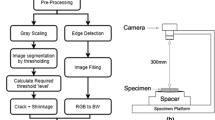Abstract
The application of soil bracing systems through the artificial ground freezing (AGF) method is developing in the field of geotechnical engineering. Retaining structures cannot be stabilized if the strength of the material used at the construction stage is not sufficient. For this reason, this study aims to investigate the usability of an innovative composite material named pykrete, which contains sustainable sawdust obtained with natural pinewood after a recycling process. The mechanical properties are inferred from different types of pine sawdust (fine, medium and coarse) with various densities (dense, medium dense and loose) at two freezing temperatures (− 20 and − 10 °C) as an advanced temporary retaining structure against lateral earth pressure. Unconfined compression tests (UCC) are applied on 60 types of pykrete samples after a freezing application in a CDF/CIF freezing–thawing machine. In addition, the micro-textural structures of the samples were examined by a light microscope in terms of freezing and thawing performance. The strain ratio’s mean values of the samples increased from 3.10 and 4.81 to 4.95% at − 20 °C, and from 5.45 and 6.04 to 6.65% at − 10 °C, according to the fine, medium and coarse sawdust types, respectively. The innovative pykrete material with a fine pinewood sawdust type and a density of 18% by weight can be used as a high-strength composite material with 4.83 MPa compressive strength within retaining structures in civil engineering applications, according to the experimental results.













Similar content being viewed by others
References
Luo H, Ning XA, Liang X, Feng Y, Liu J (2013) Effects of sawdust-CPAM on textile dyeing sludge dewaterability and flter cake properties. Bioresour Technol 139:330–336. https://doi.org/10.1016/j.biortech.2013.04.035
Melo RR, Rocha MJ, Rodolfo F Jr, Stangerlin DM (2016) Influence of diameter class on lumber yielding of Qualea sp. Brazilian J For Res 36(1):393–398. https://doi.org/10.4336/2016.pfb.36.88.1151
Melo RR, Dacroce JMF, Rodolfo F Jr, Lisboa GS, França LCJ (2019) Lumber yield of four native forest species of the Amazon Region. Floresta Ambiente 26(1):01–07. https://doi.org/10.1590/2179-8087.031116
Lima DC, Melo RR, Santana RRC, Botan E, Santana RMC, Stangerlin DM (2018) Wood plastic composites manufactured with sawmill waste and discarded polypropylene packaging. Nativa 8(1):79–84. https://doi.org/10.31413/nativa.v6i1.4432
Perutz M (1948) A description of the iceberg aircraft carrier and the bearing of the mechanical properties of frozen wood pulp upon some problems of glacier flow. J Glaciol 1(3):95–104. https://doi.org/10.3189/S0022143000007796
Vasiliev NK, Pronk ADC (2015) Ice composites as construction materials in projects of ice structures. In: The 23rd international conference on port and ocean engineering under arctic condition, Trondheim, Norway, 2015.
Aksenov VI, Gevorkyan SG, Iospa AV (2019) Temperature dependence of stress–strain properties of freshwater ice. Soil Mech Found Eng 56:366–370. https://doi.org/10.1007/s11204-019-09616-4
Evirgen B, Tuncan M (2019) A physical soil freezing model for laboratory applications. Cold Reg Sci Technol 159:29–39. https://doi.org/10.1016/j.coldregions.2018.12.005
Evirgen B (2021) Comparison of individual and sequential copper piping systems in an experimental artificial ground freezing model. Arab J Geosci 14(11):1–12. https://doi.org/10.1007/s12517-021-07305-x
Pronk ADC, de Boer MBG, van de Hoef J et al (2020) Structural design and validation of a pykrete tower through form finding. In: IASS annual symposium and surrey 7th inspiring the next generation, Guildford, 2020
Putra RF (2020) Physical and mechanical characterization of pykrete with various material composition and it's possible application. Master Dissertation, Institut Teknologi Sepuluh Nopember, Surabaya
Firdaus PR, Sulistijono AH (2020) Study of pykrete viability as protective insulation in cold storage application. AIP Conf Proc 2296(1):020082. https://doi.org/10.1063/5.0032995
Clarke BG (2017) Engineering of glacial deposits. CRC Press. https://doi.org/10.1201/9781315149356
Evirgen B (2017) Evaluation of bearing capacity and sliding potential with new generation applications in scope of geotechnical engineering. Doctoral Dissertation, Anadolu University
Jessberger HL (1980) Theory and application of ground freezing in civil engineering. Cold Reg Sci Technol 3(1):3–27. https://doi.org/10.1016/0165-232X(80)90003-8
Liu Y, Hu J, Xiao HW, Chen EJ (2017) Effects of material and drilling uncertainties on artificial ground freezing of cement-admixed soils. Can Geotech J 54(12):1659–1671. https://doi.org/10.1139/cgj-2016-0707
Wang T, Liu Y, Zhou G, Wang D (2021) Effect of uncertain hydrothermal properties and freezing temperature on the thermal process of frozen soil around a single freezing pipe. Int Commun Heat Mass Transf 124:105267. https://doi.org/10.1016/j.icheatmasstransfer.2021.105267
Li J, Tang Y, Feng W (2020) Creep behavior of soft clay subjected to artificial freeze-thaw from multiple-scale perspectives. Acta Geotech 15:2849–2864. https://doi.org/10.1007/s11440-020-00980-2
Zhou MM, Meschke G (2018) A multiscale homogenization model for strength predictions of fully and partially frozen soils. Acta Geotech 13:175–193. https://doi.org/10.1007/s11440-017-0538-0
ASTM C136-06, 2006 (2006) Standard test method for sieve analysis of fine and coarse aggregates. ASTM, West Conshohocken
Roy R, Mukhopadhyay A (2021) Tribological studies of 3D printed ABS and PLA parts. Mater Today Proc 41:856–862. https://doi.org/10.1016/j.matpr.2020.09.235
Sood R, Pradhan SK (2020) Design and development of a low-cost open-source 3D printer and its single response optimization using polylactic acid (PLA) material. Mater Today Proc 27:2981–2991. https://doi.org/10.1016/j.matpr.2020.04.905
Kong B, He S, Xia T, Ding Z (2021) Research on microstructure of soft clay under various artificial ground freezing conditions based on NMR. Appl Sci 11(4):1810. https://doi.org/10.3390/app11041810
Evirgen B, Onur MI, Tuncan M, Tuncan A (2015) Determination of the freezing effect on unconfined compression strength and permeability of saturated granular soils. J Geomate 8:1283–1287. https://doi.org/10.21660/2015.16.4369
Lan GQ, Wang YH, Chao SS (2018) Influences of specimen geometry and loading rate on compressive strength of unstabilized compacted earth block. Adv Mater Sci. https://doi.org/10.1155/2018/5034256
ASTM D5520-94, 2006 (2006) Standard test method for laboratory determination of creep properties of frozen soil samples by uniaxial compression. ASTM, Philadelphia
Liu Y, Li KQ, Li DQ, Tang XS, Gu SX (2022) Coupled thermal–hydraulic modeling of artificial ground freezing with uncertainties in pipe inclination and thermal conductivity. Acta Geotech 17(1):257–274. https://doi.org/10.1007/s11440-021-01221-w
Acknowledgements
This work was supported by [Eskisehir Technical University Commission of Scientific Research Projects] Grant Number [20ADP201]
Author information
Authors and Affiliations
Corresponding author
Rights and permissions
About this article
Cite this article
Hani, M., Evirgen, B. The Mechanical and Microstructural Properties of Artificially Frozen Sawdust–Ice Mixture (Pykrete) and Its Usability as a Retaining Structure. Int J Civ Eng 21, 119–134 (2023). https://doi.org/10.1007/s40999-022-00751-y
Received:
Revised:
Accepted:
Published:
Issue Date:
DOI: https://doi.org/10.1007/s40999-022-00751-y




